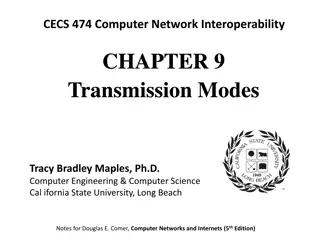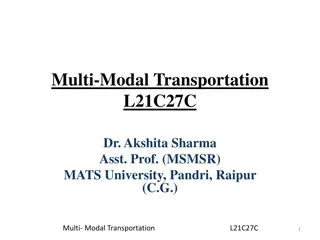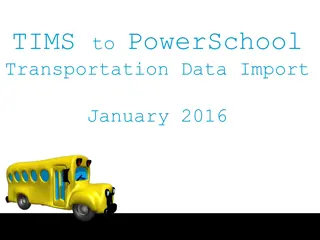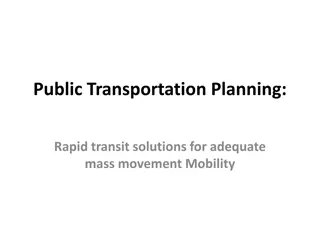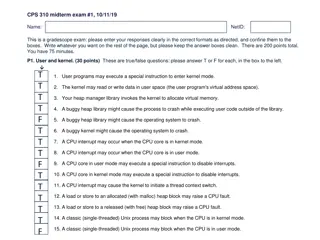Funding Opportunities for Non-Motorized Transportation in South Carolina
The US Department of Transportation's Federal Highway Administration provides funding to South Carolina through the Transportation Alternatives Program (TAP) to support non-motorized transportation initiatives. Local governments, schools, and other entities can partner with the South Carolina Depart
1 views • 21 slides
Cost Accounting Standards for Determining Transportation Costs
Understanding the importance of transportation costs in procurement and distribution, this guide outlines the standards for determining average costs, separation of transportation costs in accounting records, objectives for maintaining cost uniformity, components of transportation costs, and treatme
0 views • 11 slides
Understanding Transportation Programs and Trends
Transportation training session led by Megan Johnson, featuring topics such as Transportation Crash Course, Training Opportunities, and Transportation Trends & Updates. Includes discussions on different types of transportation services and their importance for communities.
2 views • 38 slides
Cargo Pricing Strategies Across Transportation Modes (1)
In the realm of logistics and transportation, pricing strategies play a pivotal role in shaping revenue streams and fostering competitiveness. The dynamics of cargo pricing are particularly nuanced, influenced by factors ranging from infrastructure costs to market demand and operational efficiencies
3 views • 6 slides
Richland County Transportation Improvement Summary
Richland County's transportation improvement work includes sessions on project principles, funding options, project costs, and guidelines for utilizing the transportation penny. The focus is on addressing transportation needs, project prioritization, funding challenges, and division of funds for var
0 views • 19 slides
Understanding Transport Operations: Modes, Categories, and Efficiency
Explore typical transport operations across various modes, including land, water, and air transportation. Learn about the advantages and disadvantages of different modes, such as road, railway, and air transport. Delve into scheduling long-distance trips and the impact of guidelines on transport eff
1 views • 9 slides
Understanding Addressing Modes in Computer System Architecture
Addressing modes determine how the operand in an instruction is specified, impacting the interpretation and execution. Implied, stack, immediate, direct, indirect, register direct, register indirect, relative, indexed, base register, auto-increment, and auto-decrement are various addressing modes ex
0 views • 4 slides
Understanding Transmission Modes in Computer Networks
Transmission modes in computer networks can be divided into serial and parallel modes. Parallel transmission allows multiple bits to be sent simultaneously over separate media, while serial transmission sends one bit at a time. The choice between serial and parallel transmission depends on factors s
0 views • 13 slides
Addressing Modes and Formats in Instruction Sets
This material discusses addressing modes and formats in instruction sets, covering types of addressing modes, design trade-offs, and the distinction between machine language and assembly language. It explores the need for various addressing techniques to reference locations in memory and presents co
1 views • 58 slides
Understanding Addressing Modes in Assembly Language
This content delves into the intricacies of addressing modes in assembly language, covering topics such as one-dimensional arrays, the DUP operator for defining arrays, and various modes like register, immediate, direct, and register-indirect modes. It explains how operands are specified in differen
2 views • 24 slides
Understanding Waveguides in Electromagnetic Theory
The concept of waveguides in electromagnetic theory involves the transmission of electromagnetic waves through hollow metallic tubes, such as rectangular and circular waveguides made from materials like copper and aluminum. These waveguides support different modes of propagation, including TE, TM, a
6 views • 15 slides
Understanding Addressing Modes in 8051 Microcontroller
Addressing modes in the 8051 microcontroller play a crucial role in specifying how data is accessed and operated by instructions. They include register addressing, direct addressing, register indirect addressing, immediate addressing, and indexed addressing modes. Each mode offers unique ways to han
2 views • 20 slides
Understanding Addressing Modes in 8086
Delve into the world of addressing modes in the 8086 processor to comprehend how different types of operands are accessed and utilized during instruction execution. Explore immediate, direct, register, register-indirect, and other addressing modes with detailed examples.
1 views • 17 slides
Maine DHHS Transportation Programs Overview
The Maine Department of Health and Human Services (DHHS) oversees various transportation programs aimed at providing non-emergency transportation services to low-income, child welfare-eligible, and Section 17-eligible individuals. These programs are managed through regional brokerage systems, with b
3 views • 5 slides
Understanding Multimodal Transportation in Logistics
Multimodal transportation involves using multiple modes of transportation for logistics and freight processes. It utilizes a combination of air, road, rail, water, and package carriers to efficiently move goods. Unlike intermodal shipping, multimodal shipping allows for flexibility in handling cargo
2 views • 119 slides
Coupling and Mutual Transformation of Acoustic and Gravitational Modes in Kinematically Complex Flows
This study explores the coupling and mutual transformation of acoustic and gravitational modes in kinematically complex flows. The research delves into phenomena such as stratified fluid, internal gravity waves, and formalism related to background flow and compressible cases. The presentation plan c
0 views • 20 slides
Importing TIMS Transportation Data into PowerSchool
Explore the process of extracting, formatting, purging, and importing TIMS transportation data into PowerSchool for efficient management of student transportation information. This includes creating TIMS extracts, updating bus stop information, and optimizing transportation planning through geocodin
2 views • 43 slides
Managing Higher-order Modes in Normal Conducting RF Technology
The excitation of higher-order transverse modes due to misalignments between the beam and RF structures can lead to beam instability in linear colliders. This instability can be mitigated by selectively damping the transverse modes and/or detuning the dipole mode frequencies. Understanding the diffe
0 views • 34 slides
Overview of FAST Act for Transportation Planning
The FAST Act, passed in 2015, authorizes federal programs for transportation development with a focus on surface transportation. It extends funding through 2020, totaling $304.7 billion. The Act aims to enhance resiliency, reliability, and stormwater mitigation in transportation systems. Planning fa
2 views • 10 slides
Tribal Transportation Program & Bipartisan Infrastructure Law Overview
The Tribal Transportation Program (TTP) and Bipartisan Infrastructure Law (BIL) provide funding for essential transportation projects in Tribal communities. The TTP Bridge Fund, Safety Fund, and High Priority Projects aim to improve infrastructure and safety. The BIL funding for FY22-FY26 totals $3.
1 views • 13 slides
Efficient Public Transportation Planning for Mass Mobility
Rapid transit solutions like high-capacity public transportation systems, including overground rail, underground rail, trams, and BRT systems, play a crucial role in enhancing mass movement efficiency. Factors such as journey time, transport costs, vehicle operating costs, and the benefits of rapid
1 views • 20 slides
Understanding Transit Modes: A Comparative Analysis by Watkins, LaMondia, and Brakewood
This study delves into defining transit modes, exploring different families of transit modes, and comparing mode selection in the US. The materials developed by K. Watkins, J. LaMondia, and C. Brakewood provide insights into transit mode characteristics like right-of-way systems, technology types, a
0 views • 43 slides
Understanding Rectangular Waveguides and Cutoff Frequency
Investigate waveguides supporting non-TEM modes like TE and TM, where cutoff frequency is crucial. Rectangular waveguides with TE and TM modes are explored, detailing mode orders and field configurations. The cutoff frequency formula and standard waveguide designations are also discussed, along with
0 views • 7 slides
Understanding Modes in Data Analysis
Explore the concept of modes in data analysis through examples like ice-cream sales and mathematical connections to fashion. Learn about unimodal, bimodal, and multimodal datasets and how to identify modes effectively. Discover the significance of modes in making decisions and solving real-world pro
0 views • 9 slides
DHHS Coordination of Transportation Service Contracts Overview
The Department of Health and Human Services in Maine conducted an assessment of Transportation Services in June 2019. The workgroup identified three main priorities: alignment of Quality and Performance Measures, Safety Measures, and Evaluation of Transportation Services. The first priority involves
0 views • 28 slides
Understanding Transportation and Assignment Problem
Transportation and assignment problems involve optimizing the shipment of goods from various sources to multiple destinations while minimizing total transportation costs. These problems deal with limited supply, known demand, constant shipping costs, and integer quantities. The transportation algori
0 views • 64 slides
Enhancing Transportation Infrastructure Through Federal Funding Programs
The Transportation Alternatives Program (TAP) funded by the USDOT's Federal Highway Administration supports transportation projects in South Carolina based on population categories. TAP funds are allocated to Transportation Management Areas (TMAs), Small Urban Areas, and Non-Urban Areas, prioritizin
0 views • 21 slides
Understanding Failure Modes and Effects Analysis (FMEA) Training
Failure Modes and Effects Analysis (FMEA) is a methodology that helps in process improvement by identifying and eliminating concerns early in the development of a process or design. It aims to improve customer satisfaction, manage risks, and prevent defects. Training objectives include understanding
0 views • 25 slides
Addressing Transportation Gaps in Sudbury: A Livable Community Approach
The Sudbury Transportation Committee, established by the Select Board, aims to enhance transportation in Sudbury to create a livable community. Focusing on inclusivity, equity, and addressing transportation gaps impacting various aspects of livability, the initiative seeks to improve social particip
0 views • 16 slides
Understanding Regional Coordination for Accessible Transportation
This presentation delves into the concept of regional coordination in accessible transportation, focusing on the Regional Transportation Advisory Panel, 5-year regional transportation goals, and the significance of the Safe, Accountable, Flexible, Efficient Transportation Equity Act. It emphasizes t
0 views • 16 slides
Enhancing Livability in Sudbury Through Transportation Initiatives
The GoSudbury! Transportation Update to the Select Board on October 19, 2021 highlights the importance of addressing transportation as a key component of livable communities. The initiative aims to create a safe, secure, and inclusive environment by improving transportation options for residents of
0 views • 26 slides
Regional Special Education Transportation (RSET) Program Overview
RSET, which stands for Regional Special Education Transportation, is an initiative developed by ACES to help districts save money while safely transporting students to out-of-district placement sites. The program benefits districts by reducing transportation costs, addressing parent concerns, and ma
0 views • 13 slides
Understanding Pennsylvania's Medical Assistance Transportation Program (MATP)
The Medical Assistance Transportation Program (MATP) in Pennsylvania provides essential transportation services to access medical care. Governed by state plans and codes, MATP aims to offer access to medical, pharmacy services, chronic disease management, and preventative care. Transportation provid
0 views • 16 slides
Locally-Unique Address Assignment Protocols in IEEE 802 Networks
This content discusses the Local MAC Address Protocol for locally-unique assignment of 48-bit and 64-bit addresses in IEEE 802 networks. It specifies protocols, procedures, and management objects for address assignment in a structured manner. The document also covers peer-to-peer claiming, server mo
0 views • 11 slides
Understanding ESD Force, Noise, and Range in Various Modes
This content discusses ESD force, noise, and range in different modes of operation, presenting assumptions, possible operation modes, and details on maximum range mode and noise characteristics. It explores concepts like control voltage offset, force noise calculations, and practical applications fo
0 views • 9 slides
Comprehensive Overview of Transportation in Logistics Management
Transportation plays a crucial role in logistics management by facilitating the movement of products and goods efficiently. It involves various modes like air, land, rail, road, and water transport, each with its advantages and disadvantages. The objective of transportation is to enhance port capaci
0 views • 13 slides
Understanding User and Kernel Modes in Operating Systems
The content provided discusses various aspects of user and kernel modes in operating systems through a set of true/false questions related to user programs, CPU interrupts, heap management, and process behavior in different modes. It touches on the role of the kernel in managing virtual memory, hand
0 views • 10 slides
The Time Cost Distance Model
The Time Cost Distance Model in Transit Corridors aims to illustrate the cost and time aspects of door-to-door movement along available routes and modes within a transit transport corridor while highlighting delays at borders or inspection points. The model proposes a methodology based on cost and t
0 views • 14 slides
Transportation Finance and Direct Democracy in California
Proposition 6 on November 6th has garnered attention, but voters in multiple states will decide on over 250 transportation ballot measures totaling over $55 billion. California, with a longer history and greater funding needs, has been at the forefront of transportation investments, including the us
0 views • 29 slides
Comprehensive Vision for Integrated Transportation System
A vision framework addressing the needs of bike, pedestrian, rail, and public transit across urban and rural areas, with an emphasis on safety, public health, connectivity, sustainability, and congestion relief. The framework aims to secure sufficient funding, promote active transportation, reduce r
0 views • 15 slides







